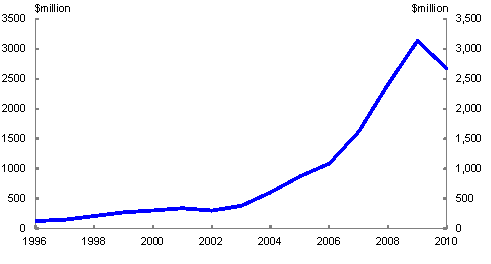Ben Ralston, Wilson Au-Yeung and Bill Brummitt1
After 20 years of economic reform this article discusses India's long-term growth potential and canvasses some of the challenges that Indian policy makers will need to overcome to realise this potential. Some of the consequences of India's growth for Australia are also explored.2
Introduction
It is 20 years since India embarked on its economic reform and liberalisation journey. These reforms have done much to unlock India's economic potential and the Australia-India bilateral economic relationship continues to blossom. India has also become an important member of fora, including the G20 and the East Asia Summit, and Australia works actively with India in these contexts.
This article assesses India's long-term growth potential, briefly surveys some of the challenges that India needs to overcome to realise its potential and finally discusses some implications for Australia.
A remarkable transformation
Today India is the fourth largest economy in the world in purchasing power parity terms. But this has not always been the case.
Despite having the world's second largest population, in 1991 the Indian economy was ranked ninth largest in the world.
At that time, the Indian economy was in turmoil, facing a current account crisis. On 24 July 1991, Manmohan Singh, then India's Finance Minister and now Prime Minister, embarked on a series of reforms that helped liberalise the Indian economy. These reforms included the relaxation of import and export restrictions, lessening of current and capital account restrictions, and an expedited removal of what many call the ‘Licence Raj'.
These reforms went further than what was needed to overcome the immediate crisis. They were instrumental in catalysing the transformation of the Indian economy that is continuing today.
The robustness of the Indian economy was demonstrated recently during the Global Financial Crisis. Economic growth in India slowed to around 6 per cent through the year (tty) in late 2008 and early 2009, then quickly recovered. Since peaking at 9.4 per cent tty in March 2010, economic growth has slowed to 7.7 per cent tty for June 2011. This slowing is in part due to the tightening of monetary policy in response to inflation.
India's projected long-term output path
Treasury has used the United Nation's long-term population projections and a conditional convergence model to derive the potential long-term economic growth rates for the world's major economies and regions.
One of the key drivers of growth for India is population growth, or more importantly the projected growth of India's working age population. The proportion of people of working age in India is expected to increase steadily until about the middle of the 2040s and reach a peak at around 67 per cent (Chart 1).
Chart 1: Working age population as a proportion of population
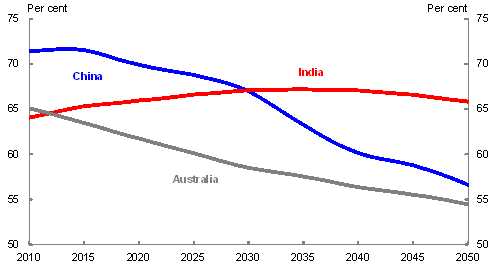
Source: UN World Population Prospects 2010 and Treasury.
This contrasts to many other countries, including Australia and most notably China. The change in the composition of India's population has been called the ‘demographic dividend'. It drives much of the projected future growth in India (Chart 2).
Chart 2: Long term projections — India, China and G7
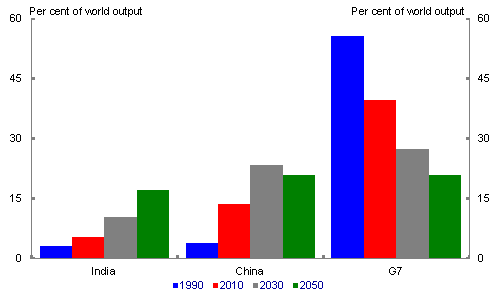
Source: Treasury, IMF and UN.
Chart 2 shows projections of the Indian, Chinese and G7 economies as a proportion of world GDP over the next 40 years. By 2050, on these projections, India could account for over 15 per cent of global GDP compared to a little over 20 per cent for China.
Based on its stronger demographic fundamentals and on the strong productivity growth flowing from the convergence process, India's potential growth rate could be faster than China's by the end of the current decade.
In terms of GDP per capita, in 2005, India's was about 5 per cent of the US. In 2050 it is anticipated to be around one-third (Chart 3).
This might not sound like much of a change, but in level terms GDP per capita for India in 2050 is expected to be around where New Zealand or Korea are today.
Chart 3: GDP per capita as a proportion of the US
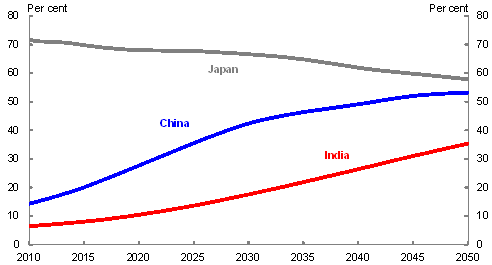
Source: Treasury, IMF and UN.
However, it should be noted that these projections are mechanical in nature and rely on demographic projections and assumptions about convergence in rates of productivity between developed and developing economies.
Caution is needed in applying assumptions about productivity growth convergence. History has shown that simply having the potential to grow at higher rates does not necessarily mean that higher rates will be achieved. The reasons for this generally revolve around technological diffusion, institutional factors, the ability to attract capital, participation in global markets and the like.3
The projections are best considered a potential outcome. The extent to which the potential is realised, or exceeded, depends on the policies that India adopts.
India's broad policy challenges centre around the basic factors of production, namely; population, land, and capital. Beyond the factors of production, productivity is the key determinant to long-run growth prospects, therefore some institutional factors are also briefly discussed.
Population
Based on UN projections, early next decade India is projected to become the world's most populous country, with 1.4 billion people. By 2050, India is expected to have 1.7 billion people, while China is expected to be the next highest with 1.4 billion people.
Chart 4: Population of India and China
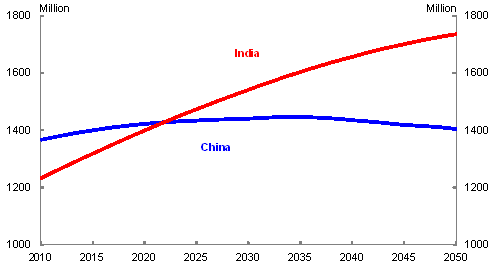
Source: UN World Population Prospects 2010 and Treasury.
To put India's growth into perspective, between now and 2050, India's population is expected to grow by around 485 million people. That is more than the present population of the US and Mexico combined.
This raises some very fundamental issues that will need to be addressed, revolving around food security and employment.
Currently, India produces a lot of its own food. Imports of major food items are comparatively low. To ensure that these additional people can be fed, India's domestic agricultural productivity has to improve dramatically or a far greater share of food will need to be imported.
Despite productivity improvements in the Indian agricultural sector over recent decades, driven by the ‘Green Revolution', India's agricultural productivity remains very low by world standards.4
For example, estimates of rice yields in India are around 3.2 tonnes per hectare, compared to 7.5 tonnes per hectare in the United States, 6.7 tonnes per hectare in China and an average of 4.3 tonnes per hectare for the world. Similar contrasts in yields have also been observed in the case of wheat, cereals
and vegetables. In fact, even the most productive Indian states fall short of world standards.5
The opportunities to improve productivity stem from improved practices in land use and rehabilitation, water efficiency and quality, crop and herd management, the mechanisation of agriculture, and upgrading of the logistical supply chain.
To meet India's food needs, the most likely scenario is that there will be some combination of the bolstering of agricultural productivity and rising imports. In meeting these challenges the balance between reform and equity will continue to pose deep political challenges for Indian governments.
There is also the issue of how and where these extra people are going to be employed. While approximately 50 per cent of the working population are employed in the agricultural sector6, agriculture only generates 15 per cent of GDP.7 India cannot continue to have 50 per cent of the working population in the agricultural sector. India's vibrant services sector will have to continue to grow and large scale manufacturing will have to expand.
Part of the solution to creating these additional jobs lies in education and labour market reform.
Education and labour market reform
The number of people between the ages of 5 and 14 in India is roughly 250 million.8 Putting aside higher education, even ensuring that enough people are provided with basic primary school education is a challenge, but it is a challenge India is winning.
According to census data, literacy rates have been improving. In 2001 literacy rates were roughly 65 per cent, while the 2011 census shows that the literacy rate is 74 per cent.
Unfortunately this higher literacy rate is yet to flow through significantly to labour market participation rates, with India's participation rate comparing unfavourably to China (Chart 5).
Chart 5: Participation rates for India and China
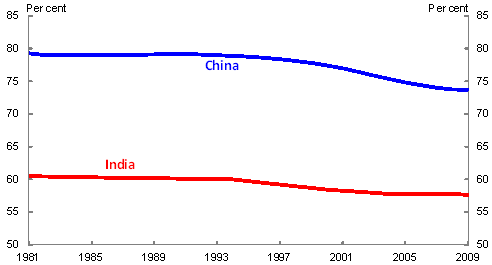
Source: International Labour Organisation.
One reason for the low participation rates and lack of formal job creation is the myriad of labour laws that inhibit market flexibility and act as deterrents to growth in the formal sector.
In 2007 the OECD noted that employment in firms with more than 10 employees accounted for around 3¾ per cent of total employment.9 This was lower than any OECD country and suggests India is failing to take advantage of its abundance of labour.
A major reason for this is that manufacturing plants with 100 employees or more require government permission to lay off just one worker. There is also the plethora of state and federal laws that combine to make the system quite complex.
In addition, the legal system adds to the difficulty. In one case where an employee was caught sleeping at work and consequently dismissed, it took over 20 years for the courts to make a final decision regarding the legality of the dismissal.10
The impact of labour laws on India's economic performance is beginning to be debated. Last year India's Prime Minister questioned whether such laws, designed to protect workers, might actually be doing more harm than good.11
It seems clear that India's outdated labour laws combine with other factors, like uncertainty in property law and other remnant regulations, in holding back growth of the formal sector.
The success of Special Economic Zones, which are relatively less regulated and taxed, and the growth of the IT sector, which is less regulated, are indicators that productivity enhancing reform is possible.
Land reform
Land reform is often a vexing policy issue for densely populated emerging economies.
Currently in India there is a restriction on the maximum size of land that can be held. This restriction is seeing an increase in the amount of smaller holdings of land as land is subdivided between siblings over successive generations. Between 1960-61 and 2002-03 the share of rural households engaged in agriculture with land holdings of less than one hectare increased from around 58 per cent (30.5 million households) to just under 80 per cent (80.4 million households) (Table 1).12
Table 1: India's rural land distribution (millions)

Source: National Sample Survey Organisation and Reserve Bank of Australia.
These small holdings make it difficult for the land owners to make a living from solely working their land. In addition, with such small holdings capital investment is difficult, which inhibits productivity growth.
Beyond the agricultural sector, land reform is a key issue in the context of industrial and infrastructure development. Land acquisition issues are a factor behind the delays in many projects13, and pressure for reform is building.
Capital
As is common in rapidly growing developing economies, the need for enhanced infrastructure in India is overwhelming.
The fast growth of the Indian economy and population has meant that increasing stress has been placed on existing infrastructure, such as electricity grids and generation capacity, railways, roads, ports, airports, irrigation, and urban and rural water supply. For example, in 2010-11, 12,200 MW of electricity system capacity was added, up from 9,600 MW the previous year, but well short of the 20,000 MW target.14
There is a general consensus that the lack of infrastructure is holding back India's economic development, particularly in the energy and transport sectors. The Indian Government acknowledges this and in its 11th Five-Year Plan (2007-2012) identified increased infrastructure spending as a priority in achieving India's economic growth.
In the upcoming Five-Year Plan, India's Planning Commission anticipates that average investment of around US$200 billion per year will be required, double the average of the current plan, to sustain India's growth. This investment is to be achieved through a combination of public investment and private initiatives, including through Public Private Partnerships (PPP).
However, there are a number of roadblocks in the way of this acceleration of investment. These include financing, public sector capacity, government clearances, land acquisition and limited capacity of contractors.15
Despite these obstacles, one area of tremendous progress has been the Indian telecommunications sector. Currently there are in excess of 850 million mobile phone subscribers16 as well as a thriving call centre industry.
Institutional factors
India is not only the world's largest democracy, it is extremely diverse, encompassing many different ethnic groups, religions, traditions, and people of vastly different economic standing. As such there exists a multitude of voices that want to be heard and a myriad of interests that all have stakes in India's economic development.
Of course there are well known problems in India with red tape, corruption and a slow
legal system. However, ultimately the democratic institutions that India has — the right to vote, an independent judiciary, and a free press — act to assist the establishment of consensus and therefore act as a unifying force. This unifying force and inclusive decision process is an important asset given the dramatic social changes that India has undergone and will need to undergo in the future.
Tax reform
India's current taxation system is complicated and difficult to administer. For example, the central government has the ability to tax the final consumption of services, but not goods. States have the ability to tax the final consumption of goods, but not services. While the central government has the legal ability to levy taxes on interstate transactions, the home State can collect and retain the tax revenue.17
The Indian Government recognises some of the problems in the taxation system and has plans to reform aspects of it with the Direct Tax Code and the introduction of a goods and services tax. However, the Indian experience with tax reform, like Australia's, is not a straightforward one and negotiations are still underway.
Red tape and bureaucracy
Perhaps a legacy of the old Licence Raj system is India's high level of red tape and bureaucracy.
This has an impact on India's ranking in the World Bank's Ease of Doing Business Index, with India ranking 134 out of 183 economies. As a practical example, this same report notes that it takes around 29 days for a business to be registered in India, while the OECD average is 5.6 days. It should be noted, however, that this is an improvement from 2008 when it took 33 days.
Corruption and the legal system
The World Bank and others have identified corruption as among the greatest obstacles to economic growth and social development.18
Anecdotally and through a number of reports, it is clear that the problem of corruption remains deeply rooted and may even be worsening in India.19 This poses a significant roadblock to its long-term growth potential.
According to Transparency International's Corruption Perception Index there has been a growing perception of corruption in India.20 This is supported by a recent public survey in India that showed that in the past three years, 74 per cent of those surveyed believed the level of corruption had increased.21 Furthermore, compared to other countries, India's ranking has fallen from 72 in 2007 to 87 in 2010 (against 178 countries).
India is trying to work its way through this sensitive area with the anti-corruption agenda clearly capturing national attention in recent times.
But further work still needs to be done as the World Corruption Perception Index has India behind countries such as China, Thailand and Columbia.
Part of the solution to the corruption challenge is having a quick and efficient court system. A mixture of reform and additional resources are needed.
The problems in the legal system also spill over into the commercial sphere, where issues such as enforceability of contracts and land disputes can act to hinder longer-term investment and consequently development.
Then there is also the law itself. Given the dramatic changes to the Indian economy over the past two decades, there are many areas where the law may not have evolved quickly enough.
Implications for Australia
India's strong growth has already seen Australia's merchandise trade exports to India rise by nearly 800 per cent from 2000 to 2010. Put differently, this has added around $14.6 billion to Australia's annual merchandise exports and seen India rise from 14th to 4th most important merchandise export destination.22
The strengthening trade relationship over the last 10 years has been largely the result of the growth in the Indian economy and its demand for resources. However, as growth in India continues and the middle class expands many more opportunities will open up.23
Resources and energy
India's growing economy is leading to increased demand for energy commodities, such as natural gas and coal, and mineral commodities like gold and copper ore.
For example, coal exports to India for 2010 were around $6.8 billion, up from $2.6 billion in 2006. India is also expected to be a large customer of the $43 billion Gorgon gas project in Western Australia.
Gold is also a very important export to India. Australia's gold exports to India have risen from $3.6 billion in 2006 to be in excess of $5.3 billion 2010. India's growth has also seen Australia's copper ore and concentrates exports rise to nearly $1.4 billion.24
However, the relationship has the potential to extend beyond simply buyer and seller. India itself has large proven deposits of its own. For example India has the fourth largest proven deposits of thermal coal in the world.25 Bauxite reserves are around 3.3 billion tons, or 7.5 per cent of global reserves, making India a net exporter of bauxite. Iron ore reserves stand at around 13.4 billion tons (fifth largest in the world) with a large percentage of reserves having high ferrous content.26
This resource endowment has seen Australian companies undertake exploration activities. Earlier this year Rio Tinto received a social awareness award from the Federation of Indian Mineral Industries for its efforts.
However, there are still many restrictions in place that make such activities difficult. A freeing up of restrictions in the mining sector would be a significant boost for the Indian economy. It would also provide international companies, with the proven expertise and equipment to develop such deposits, a significant opportunity.
But the relationship need not go only one way. Australia itself has substantial resource deposits and Indian investment in our resource and energy sector is growing strongly. For example, there has been heavy investment by Indian companies in Queensland's Galilee Basin coal fields and Adani Group has acquired from the Queensland Government a 99-year lease of the Abbot Point Coal Terminal north of Bowen.
Agriculture
India's demand for agricultural commodities and processed food items is generally outstripping its domestic productive capacity. Increasingly India is looking to global supply chains to fill the gaps, which will boost trade flows. However, there is also enormous untapped potential onshore.
As noted above, India's agricultural productivity is very low by world standards. This has led to talk of the need for a second green revolution.27
There are opportunities to improve practices in land use and rehabilitation, water efficiency and quality, crop and herd management, the mechanisation of agriculture, and upgrading the logistical supply chain. These opportunities should be attractive to Australian agribusiness, environmental and logistics firms.
India's agricultural sector will probably remain relatively heavily protected due to the political influence and poor economic and social conditions of agricultural workers.
However, liberalisation has been occurring. The new opportunities can be seasonal and temporary as imports may only be allowed when there is a domestic shortage of production. Such opportunities can be large, however infrequent and unpredictable.
India's rising middle class presents opportunities of a different nature.28 As incomes rise and the Indian consumer has exposure to international markets, tastes are changing. This translates into growth in demand for protein, imported processed foods, wine and the like.
The liberalisation of FDI in India's multi-brand retail sector could be an important force in helping to transform India's food sector — potentially boosting investment in the cold storage and supply chain, lifting agricultural productivity and incomes, and helping to alleviate food price inflation.
Infrastructure provision
As noted earlier, India has set itself ambitious targets for infrastructure with the next Five-Year Plan expected to contain total infrastructure spending of US$1 trillion. This is to be implemented with the assistance of the private sector.
There are Australian companies on the infrastructure financing side and on the construction and project management side supporting these efforts. But construction activity, and participation by the private sector, is really only just now ramping up.
India is actively seeking to modernise its PPP frameworks and attract foreign capital and know-how. Again the opportunities and possible collaboration are significant, if the domestic policy settings and investment climate can be made more conducive.
Education
Currently around 11 million Indian students are pursuing higher education — but this represents just 11 per cent of the nation's 17-23 year olds. The level of unmet demand for university places runs at around 4.7 million places each year.
Government policy is directed towards increasing the Gross Enrolment Ratio — the ratio of actual students to potential students — to 25 per cent by 2022.29
To supply the necessary places, India intends to set up around 1,500 new higher education institutions, at least one central university in each state, and 14 new innovation universities.30
The opportunities for Australian universities, whether in terms of partnering with Indian institutions during this growth phase or attracting more Indian international students to Australia are clear.
In terms of vocational education and training, the scope of opportunity is also impressive. The Australian Government has identified opportunities to increase the delivery of Australian vocational education and training (VET) qualifications in India.
At present only 2-2.5 per cent of India's population undertakes formal VET training. However, it is estimated that some 500 million people will require training by 2022 — over 21 times Australia's population. The current capacity of the Indian VET system is around 4.3 million training places.31
The challenge for India is enormous and India recognises that it cannot achieve these goals alone.
The scale of needs in India has seen our exports of education services to India experience roughly a 28 fold increase in dollars spent over the 15 years to 2010.32 These exports remain at very high levels and the whole trade is now on a much more sustainable path after the Government's series of visa reforms.33
Chart 6: Australia's exports of education services to India
Source: ABS cat. no. 5368.0 and Treasury.
Tourism
India was the eleventh largest source of tourist arrivals in 2009, while China was fourth largest. As Indian incomes continue to rise there is much future growth potential. In addition, there is also scope for a change in the focus of visits from ‘visiting friends and relatives' to ‘holidays', which would increase the economic value from Indian tourism.
This growth in outbound Indian tourism will occur against a backdrop of increased competition among potential tourist destinations. How well Australia does in capturing this market will depend greatly on the skill and creativity of Australian tourism providers.
Summary
The long term prospects for the Indian economy are very strong.
But India's policy makers must continue the reform process if India is to harness all of its growth drivers and achieve its enormous potential.
The rise of the middle-class in India will open up many new opportunities for Australia, but our success is not pre-ordained. Continued reforms to drive our competitiveness and a determined effort to better understand the Indian market will be essential.
References
Acemoglu, D, 2009, Introduction to Economic Growth, Princeton University Press, Princeton, New Jersey.
Austrade-KPMG 2008, Opportunities in infrastructure and resources in India, www.austrade.gov.au.
Cagliarini, A, and Rush, A 2011, Economic Development and Agriculture in India, Reserve Bank of Australia Bulletin, June quarter 2011.
Chakrabarty, K C, 2011, Agricultural Productivity and Credit — issues and way forward, Address by the Deputy Governor of the Reserve Bank of India at the National Seminar on Productivity in Indian Agriculture, College of Agricultural Banking, Pune, 2 September 2011.
http://www.bis.org/review/r110906a.pdf?frames=0
Department of Foreign Affairs and Trade 2010, Composition of Trade 2010, www.dfat.gov.au
Government of India, Planning Commission Eleventh Five Year Plan 2007-2012, New Delhi, 2007.
Government of India, Planning Commission Mid-Term Appraisal for Eleventh Five Year Plan 2007-2012, New Delhi, July 2010.
Guriev, S 2004, Red Tape and Corruption, Journal of Development Economics, Issue no. 73, pp 489-504.
Kharas, H, 2010, The Emerging Middle Class in Developing Countries, OECD Development Centre, OECD Publishing.
International Monetary Fund 2011, India: Article IV Consultation — Staff Report, IMF Country Report No. 11/50.
Ministry of Labour & Employment 2010, Report on Employment & Unemployment Survey 2009-10, http://labourbureau.nic.in/Final_Report_Emp_Unemp_2009_10.pdf.
National Sample Survey Organisation 2006, Livestock Ownership Across Operational Land Holding Classes in India 2002-03, NSS Report No. 493.
OECD 2007, OECD Policy Brief: Economic Survey of India 2007, OECD Publishing.
OECD 2011, OECD Economic Surveys: India 2011, OECD Publishing.
Rodrik, D, 2011, The Future of Convergence, Harvard University, paper prepared for the 2011 Jackson Hole Symposium of the Federal Reserve Bank of Kansas City, 25-27 August, 2011.
Transparency International 2010, Global Corruption Barometer 2010, http://www.transparency.org/policy_research/surveys_indices/gcb/2010
Transparency International, Corruption Perception Index, various issues 2007-2010, http://www.transparency.org
1
Ben Ralston, Wilson Au-Yeung and Bill Brummitt are from International & G20 Division of Macroeconomic Group within Treasury. This article has benefited as a result of comments and input from Matt Crooke, David Lowe and Nghi Luu. The views expressed are those of the authors and do not necessarily reflect those of The Treasury.
2 This article is based on a speech that was presented by Bill Brummitt to the Australian National University's India Business and Economic Update on 19 September 2011.
3 See Acemoglu (2009) or Rodrik (2011).
4 Chakrabarty (2011) and Cagliarini and Rush (2011) provide further discussion on trends in agricultural productivity in India.
5 Chakrabarty (2011).
6 Ministry of Labour and Employment (2010).
7 CEIC Asia database.
8 UN World Population Prospects database: The 2010 Revision.
9 OECD (2007).
10 Bharat Forge Co. Ltd. v Uttam Manohar Nakate (2005), Indian Supreme Court.
11 Indian Prime Minister Manmohan Singh's address to the 43rd Session of the Indian Labour Conference, 23 November 2010, see http://pmindia.nic.in/lspeech.asp?id=987.
12 Cagliarini and Rush (2011).
13 For example, the delays experienced by steel group Posco in the state of Orissa or Tata's Nano car plant in West Bengal.
14 Indian Planning Commission.
15 See IMF (2011) Annexe note on Infrastructure Finance Indian Challenges and Country Experiences for a more detailed discussion on the roadblocks identified above, cross-country experiences and lessons for India.
16 Telecom Regulatory Authority of India, Press Release No. 47/2011.
17 OECD (2011).
18 Transparency International provides a number of scholarly articles of the impact of corruption on economic growth and development – these can be accessed on their website via
19 For example the 2G scandal is estimated by the Comptroller and Auditor General of India to have cost USD$39 billion in lost revenue.
20 Corruption Perception Index scores relate to the perception of the degree of corruption as seen by business people, academics and country analysts - scores range between 10 (highly clean) and 0 (highly corrupt). Examining recent trends, India's score has fallen from 3.5 in 2007 to 3.3 in 2010, with recent problems relating to the Government's management of the Commonwealth Games in Delhi.
21 Transparency International Global Corruption Barometer (2010).
22 ABS cat. no. 5368.0.
23 A broader discussion on Asia's emergence and the implications of an increase in its middle-class will affect Australia is contained in Budget Statement No. 4, 2011-12.
24 Department of Foreign Affairs and Trade (2010).
25 Indian Ministry of Mines.
26 Austrade-KPMG (2008).
27 Indian Prime Minister Manmohan Singh's address to the 83rd foundation day of the Indian Council of Agricultural Research, 16 July 2011.
28 See Kharas (2010) for further estimates of Asia's middle class.
29 Indian Planning Commission.
30 Indian Planning Commission.
31 Indian Planning Commission.
32 ABS cat. no. 5368.0.
33 See press releases from the Minister for Immigration and Citizenship ‘Migration reforms to deliver Australia's skills needs', 8 February 2010, and ‘Boost to International Education sector in response to Knight review', 22 September 2011.
